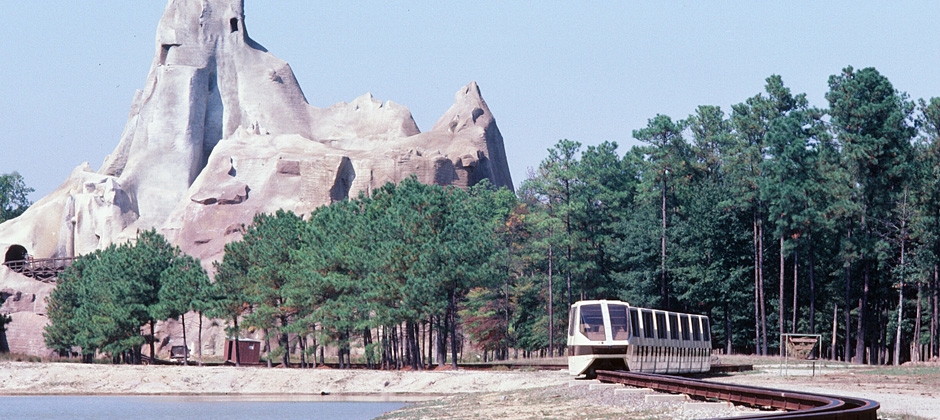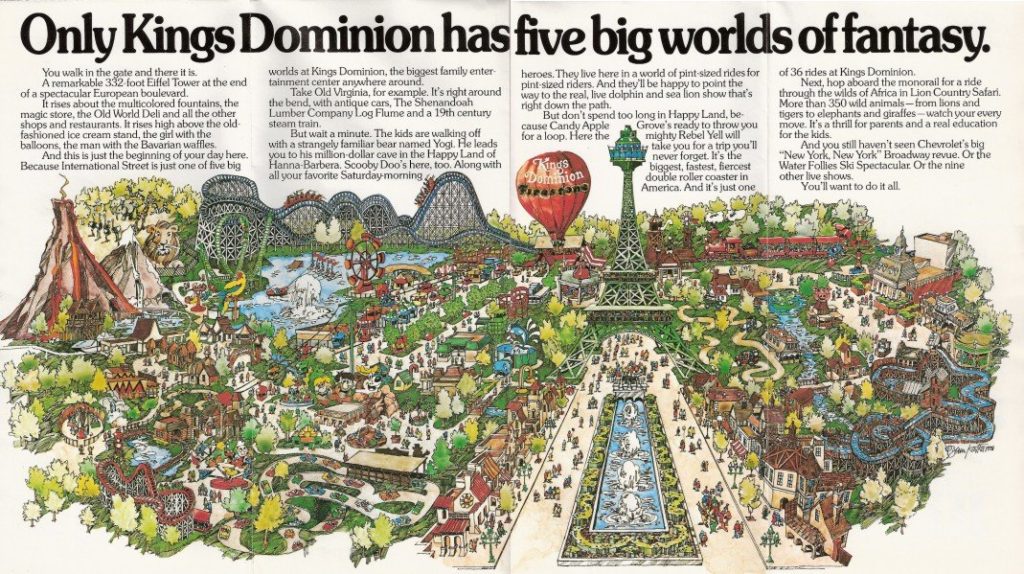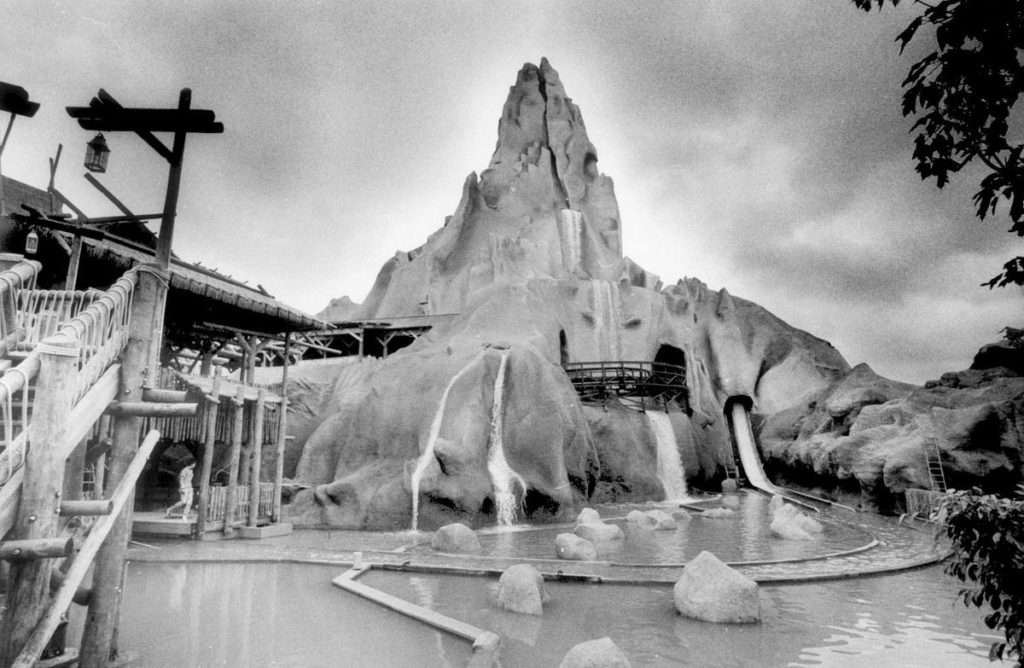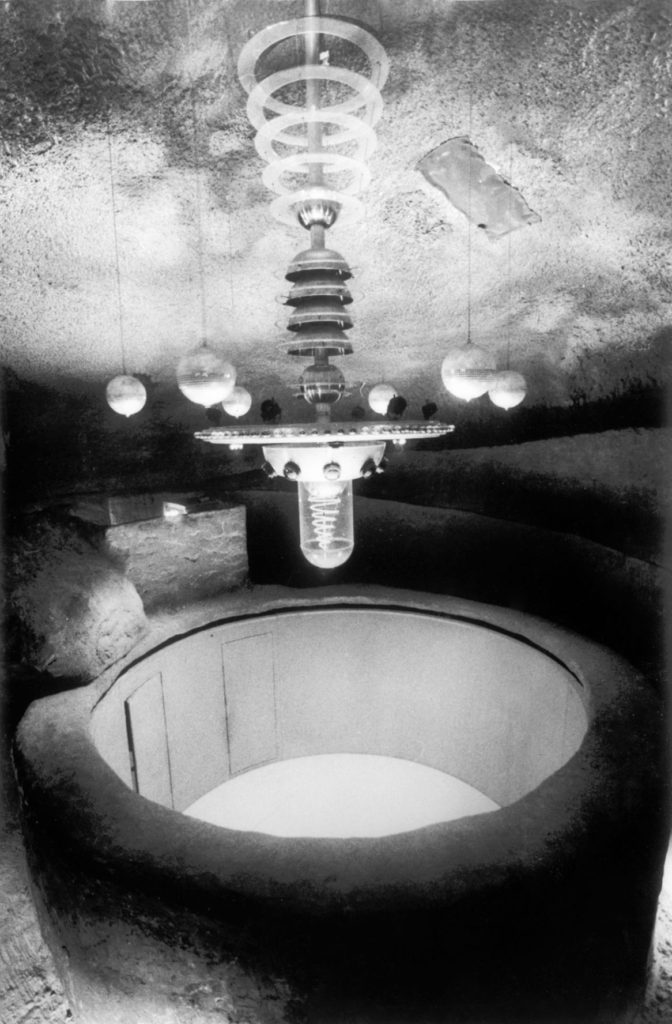Four hundred years ago, the precursor of the modern roller coaster was born. So-called “Russian mountains” were rudimentary by today’s standards, sending riders careening down frigid slopes constructed of ice and supported by wood. It’s appropriate that one of the defining roller coasters of today’s thrills was the opposite in every way: hanging from blazing steel track and racing through the fiery heart of a volcano.
Here at Park Lore, our Lost Legends collection has ridden through time to explore lost, fan-favorite coasters from Big Bad Wolf to Son of Beast. But today’s tale is particularly raw for fans of Kings Dominion near Richmond, Virginia, where an entire mountain fell, taking with it one of the most extraordinary and extreme roller coasters ever made. VOLCANO: The Blast Coaster was sincerely one-of-a-kind, using prototype technology to launch guests vertically up and out of a flaming, steaming, rumbling peak.
How did Volcano come about? What was it like to take on nature’s greatest force? What happened to make this active peak go dormant? Join us as we set off into the unknown to explore the full story, then be sure to share your memories of this explosive coaster in the comments below.
And before we head off, remember that you can unlock rare concept art and audio streams in this story, access over 100 Extra Features, and recieve an annual Membership card and postcard art set in the mail by supporting this clickbait-free, in-depth, ad-free theme park storytelling site for as little as $2 / month! Become a Park Lore Member to join the story! Until then, let’s start at the beginning…
An unexpected start

As odd and it may sound, the story of one of the world’s most intense roller coasters begins with The Flintstones, The Jetsons, Yogi Bear, Scooby-Doo, and the Smurfs. That’s because in 1966, a Cincinnati, Ohio-based television company – Taft Broadcasting – purchased Hanna-Barbera, acquiring the rights to those characters and essentially owning Saturday morning cartoons for a generation. Taft suddenly owned an intellectual property catalogue that would make Disney jealous, and had an idea of how to use it.
In 1969, Taft purchased Cincinnati’s Coney Island – a small amusement park along the Ohio River – which had been devastated by a number of floods. Their plan was to relocate what they could of Coney Island to a new, custom-built park on newly acquired land northeast of Cincinnati. There, they’d leverage the layout and lessons learned from Disney’s own 1971 Magic Kingdom and their acquisition of the Hanna-Barbera library to create one of the first modern theme parks based off Disney’s tradition.

In 1972, Kings Island opened with all the standards you’d expect post-Magic-Kingdom: a grand entryway (International Street) leading up to a park icon (a 300-foot-tall Eiffel Tower) with “spoke” paths radiating out into themed lands like Rivertown (an old Ohio settlement), Oktoberfest, Coney Island (featuring the world-record-breaking twin white tracks of the Racer), and of course, the Happy Land of Hanna-Barbera.
Kings Island was a hit for Taft Broadcasting… So much so that they decided to do it again…
Kings Dominion

Following the success of Kings Island, Taft set out to expand into a new region of the country, settling on a 400-acre site in Dowell, Virginia (just north of Richmond). The heart of the Mid-Atlantic, this East Coast park would be an attractive option for both residents and tourists from Richmond, D.C. Baltimore, Raleigh, and Norfolk. Given that this new sister to Kings Island would become an icon of “The Old Dominion,” the Virginia park was named Kings Dominion.

When Kings Dominion opened in 1975, it had a lot in common with its sister park in Cincinnati: an International Street leading to an Eiffel Tower with branches off to the Happy Land of Hanna-Barbera, an Old Virginia mining town (opposite Kings Island’s Rivertown), and even a Coney Island with a dual racing wooden coaster.
But of particular interest today is a land Kings Island had not opened with: the Lion Country Safari.

The Lion Country Safari had actually opened before the rest of Kings Dominion. It was used in 1974 as a “preview” attraction, allowing guests to drive their own personal vehicles on a route through actual zoological exhibits stocked with big cats, elephants, lions, rhinos, antelopes, and giraffes.
When Kings Dominion officially opened in 1975, the roadway was replaced with ride. Now, guests would begin their journey in the Lion Country Safari land – a thatch-roofted adventurers outpost recalling African encampments – and board a monorail (yes, a monorail!) that would carry them through the 20-minute tour of animal habitats.

In 1979, the remote Lion Country Safari would gain an equally-adventurous neighbor in one of the largest expansions the park had ever seen… No, not a volcano. At least, not yet.
The Lost World

In 1979, the park debuted the Lost World. This craggily peak reigning 170-feet over the park (nearly as tall as Cinderella Castle) isn’t so different from the never-built Discovery Mountain once planned for Disneyland Paris in that the mountain itself would’ve concealed an entire sub-land with multiple rides and attractions of its own. Decades before Disney would attempt it, Kings Dominion did it.
The multi-ride complex quickly became the park’s signature attraction, its fantasy peak rising above the forests of Virginia – a scale few would’ve expected of a regional park.

In fact, the Lost World was an intertwined complex containing three attractions:
- On “ground level” was Journey to Atlantis, an Arrow Dynamics log flume ride through fairly simple dark ride scenes of skeletons, culminating in a lift and splash into the lagoon that surrounded the peak;
- On the second story, the unusual The Land of Dooz was a from-scratch dark ride deep into the Earth to meet a race of Hobbit-like people who apparently create the world we know (cranking gears to turn the planet, pushing up growing plants, dying the Red Sea, and more) in a substantial 7-minute trip;

- Finally, guests could hike through a claustrophobic cavern and emerge overlooking the Time Shaft, a cleverly-concealed a steampunk-stylized Chance Rotor (a spinning cylinder pinning guests to the wall with centripetal force, then dropping the floor from beneath them) accentuated by music and lighting effects – a sort of “Journey to the Center of the Earth” / “Time Machine” thrill.
While the scale of the Lost World was grand (in fact, the $20 million expansion was said to be the largest and most expensive theme park expansion project ever undertaken outside of Disney’s parks), the attractions inside weren’t entirely timeless.
As a matter of fact, both dark rides would undergo substantial rewrites within a few years, each elevated to their long-lasting and most recognizable forms.

In 1980 – the year after the Lost World’s debut – the Journey to Atlantis flume ride was redesigned as The Haunted River – a ride many Virginian natives will recall. From a black light “Piranha River” and gag-filled Ancient Egypt to a graveyard and Pirates-of-the-Caribbean-influenced shipwreck, the attraction was surprisingly robust for a regional, seasonal park, and as a re-theme nonetheless!
For a generation of locals, The Haunted River may have been a test of courage for young kids. But in 1984, its upstairs neighbor became a family’s best friend. In 1984, the Land of Dooz was recrafted around Hanna-Barbera’s popular Smurfs franchise. The ride (and indeed, the entire mountain complex) was renamed Smurf Mountain in honor of its newest inhabitants.
The musical Smurf Mountain might’ve seemed like just the kind of classic family dark ride that would be beloved even to today. You can almost imagine generations of guests meeting the Smurfs through an oddball dark ride at Kings Dominion, maybe even believing the characters to be original creations designed just for the attraction. However, that’s not what happened… Kings Dominion was about to be changed forever by a new owner who had big ambitious for the Lost World mountain… Read on…


